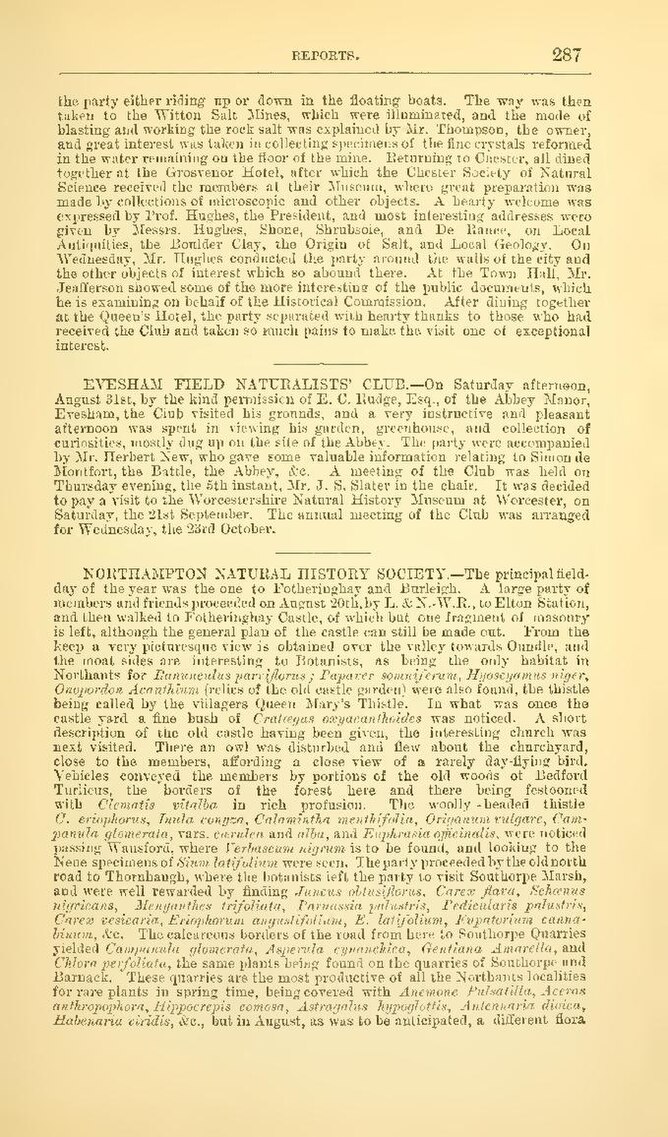the party either riding mp or down in the floating boats. The way was then taken to the Witton Salt Mines, which were illuminated, and the made of blasting and working the rock salt was explained by Mr. Thompson, the owner, and great interest was taken in collecting specimens of the fine crystals reformed in the water remaining on the floor of the mine. Returning to Chester, all dined together at the Grosvenor Hotel, after which the Chester Society of Natural Science received the members at their Museum, where great preparation was made by collections of microscopic and other objects. A hearty welcome was expressed by Prof. Hughes, the President, and most interesting addresses were given by Messrs. Hughes, Shone, Shrubsole, and De Ranee, on Local Antiquities, the Boulder Clay, the Origin of Salt, and Local Geology. On Wednesday, Mr. Hughes conducted the party around the walls of the city and the other objects of interest which so abound there. At the Town Hall, Mr. Jefferson showed some of the more interesting of the public documents, which he is examining on behalf of the Historical Commission, After dining together at the Queen's Hotel, the party separated with hearty thanks to those who had received she Club and taken so much pains to make the visit one of exceptional interest.
Evesham Field Naturalists' Club.—On Saturday afternoon, August 3lst, by the kind permission of E. C. Rudge, Esq., of the Abbey Manor, Evesham, the Club visited his grounds, and a very instructive and pleasant afternoon was spent in viewing his garden, greenhouse, and collection of curiosities, mostly dug up on the site of the Abbey. The party were accompanied by Mr. Herbert New, who gave some valuable information relating to Simon de Montfort, the Battle, the Abbey, &c. A meeting of the Club was held on Thursday evening, the 5th instant, Mr. J. S. Slater in the chair. It was decided to pay a visit to the Worcestershire Natural History Museum at Worcester, on Saturday, the 21st September, The annual meeting of the Club was arranged for Wednesday, the 23rd October.
Northampton Natural History Society.—The principal field-day of the year was the one to Fotheringhay and Burleigh. A large party of members and friends proceeded on August 20th by L. & N.-W .R., to Elton Station, and then walked to Fotheringhay Castle, of which but one fragment of masonry is left, although the general plan of the castle can still be made out. From the keep a very picturesque view is obtained over the valley towards Oundle, and the moat sides are interesting to Botanists, as being the only habitat in Northants for Ranunculus parviflorus; Papavea sonniferumm, Hyoscyamus niger, Onopordon Acanthium (relics of the old castle garden) were also found, the thistle being called by the villagers Queen Mary's Thistle. In what was once the castle yard a fine bush of Cratægus oxyacanthoides was noticed. A short description of the old castle having been given, the interesting church was next visited. There an owl was disturbed and flew about the churchyard, close to the members, affording a close view of a rarely day-fling bird. Vehicles conveyed the members by portions of the old woods to Bedford Turlieus, the borders of the forest here and there being festooned with Clematis vitelba in rich profusion. The woolly-beaded thistle C. eriophorus, Inula conyza, Calamintha menthifolia, Origanum vulgare, Campanula glomerata, vars. cærriden and alba, and Euphrasia officinalis, were noticed passing Wansford, where Verbascum nigrum is to be found, and looking to the Nene specimens of Sium latifolium were seen. The party proceeded by the old north road to Thornhaugh, where the botanists left the party to visit Southorpe Marsh, and were well rewarded by finding Juncus obtusiflorus, Carex flora, Schœnus nigricans, Menganthes trifoliata, Parnassia palustris, Pedicalaris palustris, Carex vesicaria, Eriophorum angustifolium, E. latifolium, Eupatorium cannabinum, &c.
The calcareous borders of the road from here to Southorpe Quarries yielded Campunula glomereta, Asperula cynanchica, Gentiana Amarella, and Chlora perfoliata, the same plants being found on the quarries of Sonthorpe and Barnack. These quarries are the most productive of all the Northants localities for rare plants in spring time, being covered with Anemone Pulsatilla, Aceras anthropophora, Hippocrepis comosa, Astragalus hypoglottis, Antennaria dioica, Habenaria viridis, &c., but in August, as was to be anticipated, a different flora
